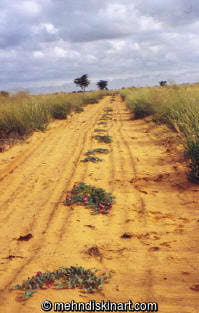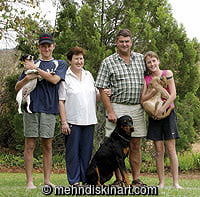|
Vogel Products
Also Try
Artosan Gel
Artosan Tablets
Artosan Liquid
Urticalcin
|
|
THE 'DEVIL' OF THE
KALAHARI
by Gerda Sorensen
In the 1960s the well-known
Swiss naturopath Alfred Vogel traveled into southern Africa to meet the
tribes people. With his natural curiosity and unassuming ways, they found
him easy to relate to and were happy to teach him about the herbs they
used to stay healthy or to treat illness.
One such herb is Devil’s Claw (Harpagophytum
procumbens) and Vogel was among the first Europeans to see the
possibilities of this rare herb, which is found only in the sands of the
Kalahari Desert.
Returning from South Africa, Alfred Vogel brought with him a quantity of
the plant tubers so that he could himself research its beneficial
properties. This resulted in the development of a tincture which he
found of benefit in offsetting joint pain.
In recent years Devil’s Claw has become known worldwide as an effective
medicine. Each year millions of wild plants are utilized to fulfill this
need, increasing the risk of over-exploitation which could threaten the
very existence of this amazing remedy, and the livelihood of the people
who harvest it.
|
|
 Cultivation
with a Conscience Cultivation
with a Conscience
Aware of the potential difficulties that this growing popularity could
cause and inspired by Alfred Vogel’s philosophy of working in harmony
with nature, herbal remedy manufacturer Bioforce has been involved for
many years with scientists from the University of Münster in Germany and
with native African experts to develop a unique, sustainable method of
cultivating Devil’s Claw – a herb which is notoriously difficult to
cultivate.
Plants are grown from seed – and the Devil’s Claw does not give up its
seeds easily. The young primary tubers are planted in carefully prepared
strips of land using an organic protocol both to ensure top quality
plants and to minimize impact on the natural environment.
It takes four years for a plant to mature and only then does the local
workforce hand harvest the long thin secondary storage tubers from deep
in the dry savannah. The main tuber is then replanted and left to grow
once more to maturity.
Having achieved considerable success with this joint venture the next
step is to ensure that local native farmers have the opportunity to
become involved in sustainable cultivation. However, as any crop grown
from scratch takes fully four years to mature, it requires both careful
planning and considerable financial support.
|
|
 The
Next Step The
Next Step
A local farmer, Louis Hauman, whose family has
worked the land for generations, owns a 7000 hectare cattle farm,
Soetvlakte, in the area. In a joint venture between Mr Hauman, the
German Embassy in South Africa and Bioforce, he has donated 25 hectares
which he has prepared for cultivation.
One of the reasons for Hauman’s involvement is his interest in ensuring
that South African land reform does not take the negative turn
experienced in Zimbabwe. ‘We have to make sure that we do not simply
give land to the tribespeople; we must also help them to develop their
skills to enable them to become successful farmers.’
The aim of the project is to enable a family from the local Tswana tribe
to learn how to cultivate Devil’s Claw successfully and to be
financially secure while they wait the four years for their first
harvest. They will also get a brand new house, fully equipped with
kitchen utilities, furniture, running water and electricity, all farming
tools and horses/donkeys to help with the heavy work and a higher than
average monthly income for four years, along with advice from Louis
Hauman on farming methods.
The scientific coordinator is Professor Dieter von Willert from the
University of Münster – known locally as Mr Harpago. It was he who,
working with Bioforce, successfully ran the initial Devil’s Claw
cultivation project on a neighbouring farm. Professor von Willert, who
spends much of his time in Africa, will also lend his advice, experience
and support directly to the native farmers.
One crucial aspect of the project is the availability of young tubers,
which must be planted continuously. The seed has a very low germination
rate and at present germination takes place both at Münster University
and at Bioforce in Switzerland. However, a germination project is being
established at a local native school, Kitlanyang, where the students are
learning to produce the young tubers ready for planting.
|
|
The Family
It goes without saying that the project family has been
chosen very carefully. Six families applied and in September
2003 one was chosen. The criteria were dependability,
stability, self motivation, technical knowledge and farming
skills. Part of the ongoing work will be the continuous
weeding of the cleared strips in which the Devil’s Claw
grows, as the strips offer good growing conditions for
plants, such as wild cucumber, which must be kept in check.
The chosen family are George Mmuluki
Hendricks and his partner Virginia Segametsi Ebuseng. George
and Virginia have two sons; Stephans Teko (14) and Thabang
(1) whom they refer to as their ‘surprise package’! They
also have help from a young man called Malkop whom they have
more or less adopted.
George was born at Soetvlakte – he is
half Tswana, half San – and grew up with Louis, learning to
be a good farmer. He is a diligent worker and Louis is sorry
to lose his services but knows that this is a great
opportunity for George and his family.
The family has gone into the project
with some trepidation but they have Louis’ support and
realize that it is a rare opportunity to work for themselves
on their own land. They will have more time for the children
and can look forward to saving money for retirement.
As to Mr Hauman’s motives, ‘Apart from
the need for land reform I also take personal pleasure in
knowing that somebody who has worked so hard for me now has
a chance to create a life on his own. The farm will
hopefully benefit from more eco-tourism and, if the project
succeeds, it will provide work opportunities during the dry
season. I also enjoy setting an example of commercial
farming for the people in Kuruman.’
We hope to revisit Soetvlakte in years
to come to learn of their progress. In the meantime we wish
George and Virginia the best of luck with this exciting
venture!
|
|
The statements
have not been evaluated by the Food and Drug Administration.
This product is not meant to diagnose, treat, cure or prevent any disease.
©1999 - 2019
Mehndi Skin Art . All rights reserved.
Terms of Use | Privacy
|
 Ayurvedic & Herbal Health Medicine
Ayurvedic & Herbal Health Medicine Ayurvedic & Herbal Health Medicine
Ayurvedic & Herbal Health Medicine![]()